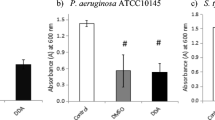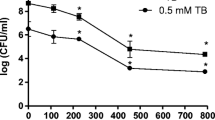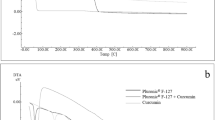Abstract
The effect of photodynamic inactivation (PDI) sensitized by 5,10,15,20-tetra(4-N,N,N-trimethylammoniophenyl)porphyrin (TMAP4+) on different components of mono- and dual-species biofilms of Staphylococcus aureus and Escherichia coli was determined by different methods. First, the plate count technique showed that TMAP4+-PDI was more effective on S. aureus than E. coli biofilm. However, crystal violet staining revealed no significant differences between before and after PDI biofilms of both bacteria. On the other hand, the 3-(4,5-dimethylthiazol-2-yl)-2,5-diphenyltetrazolium bromide method indicated a reduction in viable cells as the light exposure time increases in both, mono- and dual-species biofilms. Furthermore, it was determined that as the irradiation time increases, the amount of extracellular polymeric substances present in the biofilms decreased. This effect was presented in both strains and in the mixed biofilm, being more evident in S. aureus mono-specie biofilm. Finally, scanning electron microscopy analysis showed a decrease in the number of cells forming the biofilm after photosensitization treatments. This information makes it possible to determine whether the photodynamic action is based on damage to metabolic activity, extracellular matrix and/or biomass, which may be useful in establishing a fully effective PDI protocol for the treatment of microorganisms growing as biofilms.
Graphical abstract







Similar content being viewed by others
Data availability
All research data are detailed in the manuscript or can be found in the reference cited in the manuscript.
References
Orazi, G., & O’Toole, G. A. (2020). “It takes a village”: Mechanisms underlying antimicrobial recalcitrance of polymicrobial biofilms. Journal of Bacteriology, 202, e00530-e619. https://doi.org/10.1128/jb.00530-19
Anju, V. T., Busi, S., Imchen, M., Kumavath, R., Mohan, M. S., Salim, S. A., Subhaswaraj, P., & Dyavaiah, M. (2022). Polymicrobial infections and biofilms: Clinical significance and eradication strategies. Antibiotics, 11, 1731. https://doi.org/10.3390/antibiotics11121731
Sauer, K., Stoodley, P., Goeres, D. M., Hall-Stoodley, L., Burmølle, M., Stewart, P. S., & Bjarnsholt, T. (2022). The biofilm life cycle—Expanding the conceptual model of biofilm formation. Nature Reviews Microbiology, 20(10), 608. https://doi.org/10.1038/s41579-022-00767-0
Kranjec, C., Morales Angeles, D., Torrissen Mårli, M., Fernández, L., García, P., Kjos, M., & Diep, D. B. (2021). Staphylococcal biofilms: Challenges and novel therapeutic perspectives. Antibiotics, 10, 131. https://doi.org/10.3390/antibiotics10020131
Reynoso, E., Ferreyra, D. D., Durantini, E. N., & Spesia, M. B. (2019). Photodynamic inactivation to prevent and disrupt Staphylococcus aureus biofilm under different media conditions. Photodermatology, Photoimmunology & Photomedicine, 35, 322. https://doi.org/10.1111/phpp.12477
Pinto, R. M., Soares, F. A., Reis, S., Nunes, C., & Van Dijck, P. (2020). Innovative strategies toward the disassembly of the EPS matrix in bacterial biofilms. Frontiers in Microbiology, 11, 952. https://doi.org/10.3389/fmicb.2020.00952
Banerjee, S., Ghosh, D., Vishakha, K., Das, S., Mondal, S., & Ganguli, A. (2020). Photodynamic antimicrobial chemotherapy (PACT) using riboflavin inhibits the mono and dual species biofilm produced by antibiotic resistant Staphylococcus aureus and Escherichia coli. Photodiagnosis and Photodynamic Therapy, 32, 102002. https://doi.org/10.1016/j.pdpdt.2020.102002
Hu, X., Huang, Y.-Y., Wang, Y., Wang, X., & Hamblin, M. R. (2018). Antimicrobial photodynamic therapy to control clinically relevant biofilm infections. Frontiers in Microbiology, 9, 1299. https://doi.org/10.3389/fmicb.2018.01299
Kim, S.-H., Park, S.-H., Kim, S.-S., & Kang, D.-H. (2019). Inactivation of Staphylococcus aureus biofilms on food contact surfaces by superheated steam treatment. Journal of Food Protection, 82(9), 1496. https://doi.org/10.4315/0362-028X.JFP-18-572
Toté, K., Berghe, D. V., Maes, L., & Cos, P. (2007). A new colorimetric microtitre model for the detection of Staphylococcus aureus biofilms. Letters in Applied Microbiology, 46(2), 249. https://doi.org/10.1111/j.1472-765X.2007.02298.x
Simonetti, O., Rizzetto, G., Radi, G., Molinelli, E., Cirioni, O., Giacometti, A., & Offidani, A. (2021). New perspectives on old and new therapies of staphylococcal skin infections: The role of biofilm targeting in wound healing. Antibiotics, 10, 1377. https://doi.org/10.3390/antibiotics10111377
Lin, S., Yang, L., Chen, G., Li, B., Chen, D., Li, L., & Xu, Z. (2017). Pathogenic features and characteristics of food borne pathogens biofilm: Biomass, viability and matrix. Microbial Pathogenesis, 111, 285. https://doi.org/10.1016/j.micpath.2017.08.005
Peeters, E., Nelis, H. J., & Coenye, T. (2008). Comparison of multiple methods for quantification of microbial biofilms grown in microtiter plates. Journal of Microbiological Methods, 72, 157. https://doi.org/10.1016/j.mimet.2007.11.010
Achinas, S., Keimpe Yska, S., Charalampogiannis, N., Krooneman, J., & JanWillem Euverink, G. (2020). A technological understanding of biofilm detection techniques: A review. Materials, 13, 3147. https://doi.org/10.3390/ma13143147
Theuretzbacher, U., Baraldi, E., Ciabuschi, F., & Callegari, S. (2023). Challenges and shortcomings of antibacterial discovery projects. Clinical Microbiology and Infection, 29, 610. https://doi.org/10.1016/j.cmi.2022.11.027
Spesia, M. B., & Durantini, E. N. (2022). Evolution of phthalocyanine structures as photodynamic agents for bacteria inactivation. The Chemical Record, 22(4), e202100292. https://doi.org/10.1002/tcr.202100292
Ravazzi, R., Neves, J. G., Santamaria, M.P., Pereira Rosa, L., Silva Rosa, F. C., & Santamaria, M. Jr. (2023). Porphyrin-associated fluorescence spectroscopy (Photogen®) for the optical diagnosis of dental biofilm in orthodontic treatment: An observational clinical trial. Photodiagnosis and Photodynamic Therapy, 42, 103580. https://doi.org/10.1016/j.pdpdt.2023.103580
Li, Y., Du, J., Huang, S., Wang, S., Wang, Y., Cai, Z., Lei, L., & Huang, X. (2022). Hydrogen peroxide potentiates antimicrobial photodynamic therapy in eliminating Candida albicans and Streptococcus mutans dual-species biofilm from denture base. Photodiagnosis and Photodynamic Therapy, 37, 102691. https://doi.org/10.1016/j.pdpdt.2021.102691
Songca, S. P., & Adjei, Y. (2022). Applications of antimicrobial photodynamic therapy against bacterial biofilms. International Journal of Molecular Sciences, 23, 3209. https://doi.org/10.3390/ijms23063209
Vinagreiro, C. S., Zangirolami, A., Schaberle, F. A., Nunes, S. S. C. C., Blanco, K. C., Inada, N. M., da Silva, G. J., Pais, A. C. C., Bagnato, V. S., Arnaut, L. G., & Pereira, M. (2020). Antibacterial photodynamic inactivation of antibiotic-resistant bacteria and biofilms with nanomolar photosensitizer concentrations. ACS Infectious Diseases, 6, 1517. https://doi.org/10.1021/acsinfecdis.9b00379
Sen, P., & Nyokong, T. (2021). Enhanced Photodynamic inactivation of Staphylococcus aureus with Schiff base substituted Zinc phthalocyanines through conjugation to silver nanoparticles. Journal of Molecular Structure, 1232, 130012. https://doi.org/10.1016/j.molstruc.2021.130012
Spesia, M. B., & Durantini, E. N. (2023). Photosensitizers combination approach to enhance photodynamic inactivation of planktonic and biofilm bacteria. Photochemical and Photobiological Sciences, 22(10), 2433. https://doi.org/10.1007/s43630-023-00461-x
Caminos, D. A., Spesia, M. B., & Durantini, E. N. (2006). Photodynamic inactivation of Escherichia coli by novel meso-substituted porphyrins by 4-(3-N, N, N-trimethylammoniumpropoxy)phenyl and 4-(trifluoromethyl)phenyl groups. Photochemical and Photobiological Sciences, 5, 56. https://doi.org/10.1039/b513511g
Gsponer, N. S., Spesia, M. B., & Durantini, E. N. (2015). Effects of divalent cations, EDTA and chitosan on the uptake and photoinactivation of Escherichia coli mediated by cationic and anionic porphyrins. Photodiagnosis and Photodynamic Therapy, 12, 67. https://doi.org/10.1016/j.pdpdt.2014.12.004
Merchat, M., Spikes, G., Bertoloni, G., & Jori, G. (1996). Studies on the mechanism of bacteria photosensitization by meso-substituted cationic porphyrins. Journal of Photochemistry and Photobiology B: Biology, 35, 149. https://doi.org/10.1016/s1011-1344(96)07321-6
Kragh, K. N., Alhede, M., Kvich, L., & Bjarnsholt, T. (2019). Into the well—A close look at the complex structures of a microtiter biofilm and the crystal violet assay. Biofilm, 1, 100006. https://doi.org/10.1016/j.bioflm.2019.100006
Barbosa, I. (2003). Improved and simple micro assay for sulfated glycosaminoglycans quantification in biological extracts and its use in skin and muscle tissue studies. Glycobiology, 13(9), 647. https://doi.org/10.1093/glycob/cwg082
Spesia, M. B., Caminos, D. A., Pons, P., & Durantini, E. N. (2009). Mechanistic insight of the photodynamic inactivation of Escherichia coli by a tetracationic zinc(II) phthalocyanine derivative. Photodiagnosis and Photodynamic Therapy, 6, 52. https://doi.org/10.1016/j.pdpdt.2009.01.003
Novaira, M., Cormick, M. P., & Durantini, E. N. (2012). Spectroscopic and time-resolved fluorescence emission properties of a cationic and an anionic porphyrin in biomimetic media and Candida albicans cells. Journal of Photochemistry and Photobiology A: Chemistry, 246, 67. https://doi.org/10.1016/j.jphotochem.2012.06.024
Ferreyra, D. D., Reynoso, E., Cordero, P., Spesia, M. B., Alvarez, M. G., Milanesio, M. E., & Durantini, E. N. (2016). Synthesis and properties of 5,10,15,20-tetrakis[4-(3-N, N-dimethylaminopropoxy) phenyl] chlorin as potential broad-spectrum antimicrobial photosensitizers. Journal of Photochemistry & Photobiology, B: Biology, 158, 243. https://doi.org/10.1016/j.jphotobiol.2016.02.021
Flemming, H.-C., Wingender, J., Szewzyk, U., Steinberg, P., Rice, S. A., & Kjelleberg, S. (2016). Biofilms: An emergent form of bacterial life. Nature Reviews Microbiology, 14(9), 563. https://doi.org/10.1038/nrmicro.2016.94
Wilson, C., Lukowicz, R., Merchant, S., Valquier-Flynn, H., Caballero, J., Sandoval, J., Okuom, M., Huber, C., Durham Brooks, T., Wilson, E., Clement, B., Wentworth, C. D., & Holmes, A. E. (2017). Quantitative and qualitative assessment methods for biofilm growth: A mini-review. Research & Reviews: Journal of Engineering and Technology, 6(4), 1.
Millezi, F. M., Pereira, M. O., Batista, N. N., Camargos, N., Auad, I., Cardoso, M. D. G., & Piccoli, R. H. (2012). Susceptibility of monospecies and dual-species biofilms of Staphylococcus aureus and Escherichia coli to essential oils. Journal of Food Safety, 32(3), 351. https://doi.org/10.1111/j.1745-4565.2012.00387.x
Pompermayer, D. M., & Gaylarde, C. C. (2000). The influence of temperature on the adhesion of mixed cultures of Staphylococcus aureus and Escherichia coli to polypropylene. Food Microbiology, 17, 361. https://doi.org/10.1006/fmic.1999.0291
Martinez, S. R., Ibarra, L. E., Ponzio, R. A., Forcone, M. V., Wendel, A. B., Chesta, C. A., Spesia, M. B., & Palacios, R. E. (2020). Photodynamic inactivation of ESKAPE group bacterial pathogens in planktonic and biofilm cultures using metallated porphyrin-doped conjugated polymer nanoparticles. ACS Infectious Diseases, 6(8), 2202. https://doi.org/10.1021/acsinfecdis.0c00268
Grela, E., Kozłowska, J., & Grabowiecka, A. (2018). Current methodology of MTT assay in bacteria—A review. Acta Histochemica, 120(4), 303. https://doi.org/10.1016/j.acthis.2018.03.007
Ghasemi, M., Turnbull, T., Sebastian, S., & Kempson, I. (2021). The MTT assay: Utility, limitations, pitfalls, and interpretation in bulk and single-cell analysis. International Journal of Molecular Sciences, 22, 12827. https://doi.org/10.3390/ijms222312827
Tan, L., Li, H., Chen, B., Huang, J., Li, Y., Zheng, H., Liu, H., Zhao, Y., & Wang, J. J. (2021). Dual-species biofilms formation of Vibrio parahaemolyticus and Shewanella putrefaciens and their tolerance to photodynamic inactivation. Food Control, 125, 107983. https://doi.org/10.1016/j.foodcont.2021.107983
Wang, H., Cheng, H., Wang, F., Wei, D., & Wang, X. (2010). An improved 3-(4,5-dimethylthiazol-2-yl)-2,5-diphenyl tetrazolium bromide (MTT) reduction assay for evaluating the viability of Escherichia coli cells. Journal of Microbiological Methods, 82(3), 330. https://doi.org/10.1016/j.mimet.2010.06.014
Misba, L., Abdulrahman, H., & Khan, A. U. (2019). Photodynamic efficacy of toluidine blue O against mono species and dual species bacterial biofilm. Photodiagnosis and Photodynamic Therapy, 26, 383. https://doi.org/10.1016/j.pdpdt.2019.05.001
Beirão, S., Fernandes, S., Coelho, J., Faustino, M. A. F., Tomé, J. P. C., Neves, M. G. P. M. S., Tome, A. C., Almeida, A., & Cunha, A. (2014). Photodynamic inactivation of bacterial and yeast biofilms with a cationic porphyrin. Photochemistry and Photobiology, 90, 1387. https://doi.org/10.1111/php.12331
Pereira, C. A., Romeiro, R. L., Borges Pereira Costa, A. C., Silva Machado, A. K., Campos Junqueira, J., & Olavo Cardoso Jorge, A. (2011) Susceptibility of Candida albicans, Staphylococcus aureus and Streptococcus mutans biofilms to photodynamic inactivation: an in vitro study. Lasers in Medical Science, 26, 341. https://doi.org/10.1007/s10103-010-0852-3
Acknowledgements
Authors are grateful to Consejo Nacional de Investigaciones Científicas y Técnicas (CONICET) of Argentina and Agencia Nacional de Promoción Científica y Tecnológica (FONCYT PICT N°1482/19 and 2391/19) for financial support. R.B.A. thanks CONICET for the research fellowship. E.N.D. and M.B.S. are Scientific Members of CONICET. Special thanks to D.F.B.P.
Funding
Fondo para la Investigación Científica y Tecnológica, PICT N°1482/19, Mariana B. Spesia, PICT N° 2391/19, Edgardo N. Durantini.
Author information
Authors and Affiliations
Corresponding author
Ethics declarations
Conflict of interest
The authors declare that they have no conflict of interest.
Rights and permissions
Springer Nature or its licensor (e.g. a society or other partner) holds exclusive rights to this article under a publishing agreement with the author(s) or other rightsholder(s); author self-archiving of the accepted manuscript version of this article is solely governed by the terms of such publishing agreement and applicable law.
About this article
Cite this article
Acosta, R.B., Durantini, E.N. & Spesia, M.B. Evaluation of quantification methods to determine photodynamic action on mono- and dual-species bacterial biofilms. Photochem Photobiol Sci (2024). https://doi.org/10.1007/s43630-024-00586-7
Received:
Accepted:
Published:
DOI: https://doi.org/10.1007/s43630-024-00586-7




